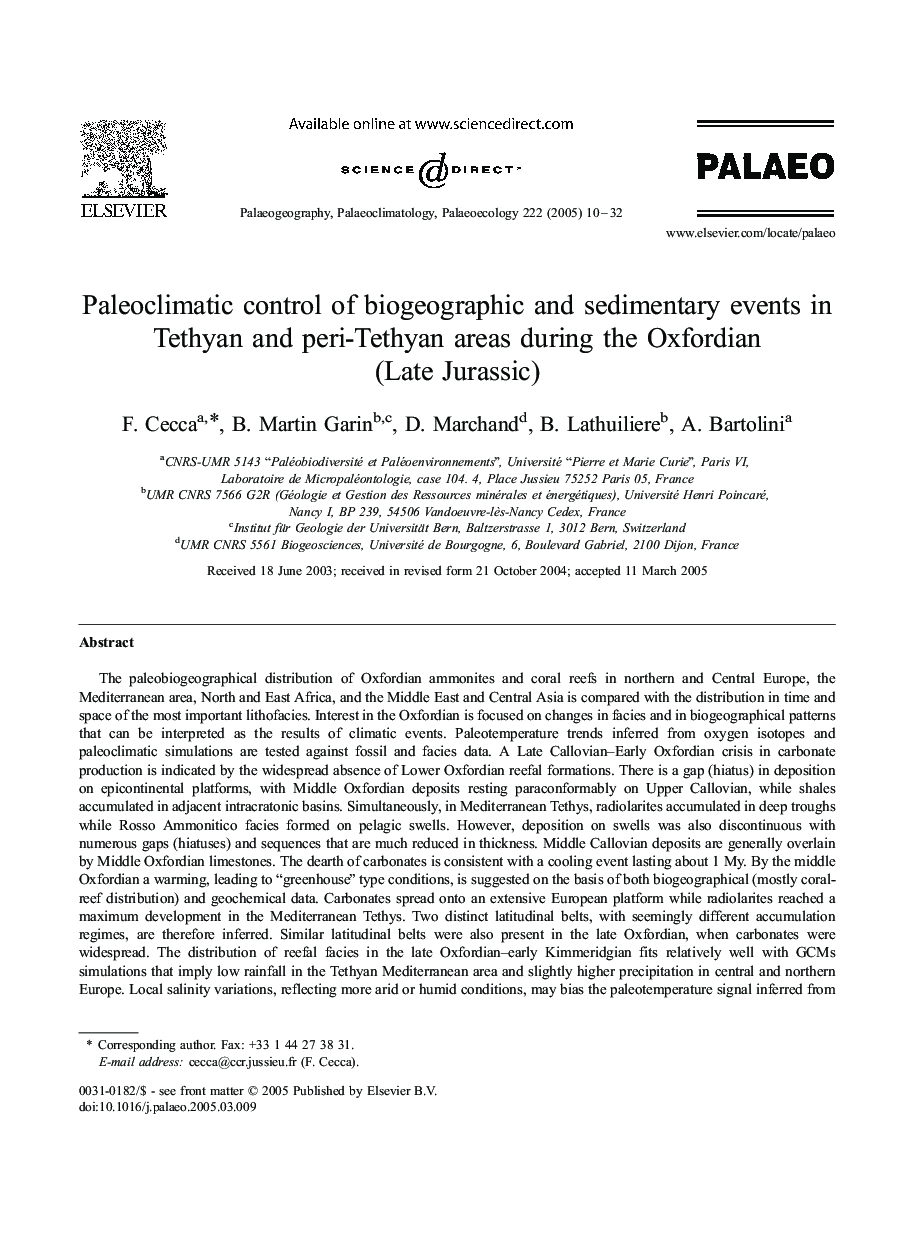| کد مقاله | کد نشریه | سال انتشار | مقاله انگلیسی | نسخه تمام متن |
|---|---|---|---|---|
| 9463144 | 1622393 | 2005 | 23 صفحه PDF | دانلود رایگان |
عنوان انگلیسی مقاله ISI
Paleoclimatic control of biogeographic and sedimentary events in Tethyan and peri-Tethyan areas during the Oxfordian (Late Jurassic)
دانلود مقاله + سفارش ترجمه
دانلود مقاله ISI انگلیسی
رایگان برای ایرانیان
کلمات کلیدی
موضوعات مرتبط
مهندسی و علوم پایه
علوم زمین و سیارات
فرآیندهای سطح زمین
پیش نمایش صفحه اول مقاله

چکیده انگلیسی
The paleobiogeographical distribution of Oxfordian ammonites and coral reefs in northern and Central Europe, the Mediterranean area, North and East Africa, and the Middle East and Central Asia is compared with the distribution in time and space of the most important lithofacies. Interest in the Oxfordian is focused on changes in facies and in biogeographical patterns that can be interpreted as the results of climatic events. Paleotemperature trends inferred from oxygen isotopes and paleoclimatic simulations are tested against fossil and facies data. A Late Callovian-Early Oxfordian crisis in carbonate production is indicated by the widespread absence of Lower Oxfordian reefal formations. There is a gap (hiatus) in deposition on epicontinental platforms, with Middle Oxfordian deposits resting paraconformably on Upper Callovian, while shales accumulated in adjacent intracratonic basins. Simultaneously, in Mediterranean Tethys, radiolarites accumulated in deep troughs while Rosso Ammonitico facies formed on pelagic swells. However, deposition on swells was also discontinuous with numerous gaps (hiatuses) and sequences that are much reduced in thickness. Middle Callovian deposits are generally overlain by Middle Oxfordian limestones. The dearth of carbonates is consistent with a cooling event lasting about 1 My. By the middle Oxfordian a warming, leading to “greenhouse” type conditions, is suggested on the basis of both biogeographical (mostly coral-reef distribution) and geochemical data. Carbonates spread onto an extensive European platform while radiolarites reached a maximum development in the Mediterranean Tethys. Two distinct latitudinal belts, with seemingly different accumulation regimes, are therefore inferred. Similar latitudinal belts were also present in the late Oxfordian, when carbonates were widespread. The distribution of reefal facies in the late Oxfordian-early Kimmeridgian fits relatively well with GCMs simulations that imply low rainfall in the Tethyan Mediterranean area and slightly higher precipitation in central and northern Europe. Local salinity variations, reflecting more arid or humid conditions, may bias the paleotemperature signal inferred from δ18O values. Biogeographical and facies distributions, combined with δ18O values, unravel the ambiguity and support a Late Callovian-Early Oxfordian cooling followed by warming in the later Oxfordian.
ناشر
Database: Elsevier - ScienceDirect (ساینس دایرکت)
Journal: Palaeogeography, Palaeoclimatology, Palaeoecology - Volume 222, Issues 1â2, 21 June 2005, Pages 10-32
Journal: Palaeogeography, Palaeoclimatology, Palaeoecology - Volume 222, Issues 1â2, 21 June 2005, Pages 10-32
نویسندگان
F. Cecca, B. Martin Garin, D. Marchand, B. Lathuiliere, A. Bartolini,